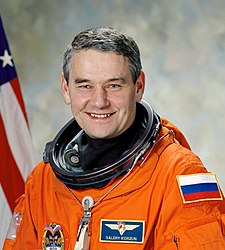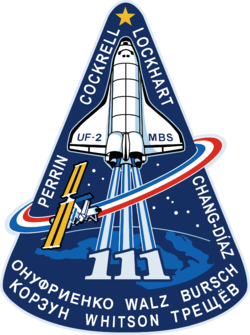Valerij Korzun
| Valerij Grigorjevič Korzun | |
|---|---|
 | |
| Kosmonaut CPK | |
| Státní příslušnost | SSSR/Rusko |
| Datum narození | 3. května 1953 (69 let) |
| Místo narození | |
| Předchozí zaměstnání | pilot |
| Hodnost | plukovník |
| Čas ve vesmíru | 381 dní, 15 hodin a 41 minut |
| Kosmonaut od | 1987 |
| Mise | Sojuz TM-24, STS-111, Expedice 5, STS-113 |
| Znaky misí | |
| Některá data mohou pocházet z datové položky. | |
Valerij Grigorjevič Korzun, rusky Валерий Григорьевич Корзун, (* 3. května 1953 Krasnyj Sulin, Rostovská oblast, SSSR – nyní Rusko) je bývalý ruský kosmonaut z letů Sojuzů i raketoplánu, který strávil na orbitálních stanicích Mir a ISS přes rok svého života.
Život
Mládí a výcvik
Valerij Korzun se narodil v městě Krasnyj Sulin v Rostovské oblasti, je ruské národnosti.[1] V rodném městě ukončil střední školu (Krasnosulinskaja srednjaja škola No 2) v roce 1970 a nastoupil do armády. Vojenským pilotem se stal roku 1974 po absolvování příslušné školy (Kačinskoje vysšeje vojenno aviacionnoje učilišče im. A.F. Mjasnikova). V letech 1984 – 1985 absolvoval velitelskou vojenskou školu Krasnoznamennaja vojenno-vozdušnaja akademija im. J.A. Gagarina, Monino.
Od roku 1987 byl ve výcvikovém středisku kosmonautů Centr podgotovki kosmonavtov im. J. A. Gagarina ve Hvězdném městečku. Po 9 letech letěl do vesmíru.
Rodina, osobní život
Je ženatý, jeho manželkou je Jelena Ivanovna, rozená Nazinaja. Spolu mají od roku 1979 chlapce Nikitu.
Lety do vesmíru
První let absolvoval v létě roku 1996 (bylo mu 43 let) na palubě ruské kosmické lodě Sojuz TM-24. Spolu s ním letěli Alexandr Kaleri a Claudie André-Deshaysová z Francie. Loď byla katalogizována v COSPAR jako 1996-047A. Startovali z Bajkonuru a dva dny poté se připojili ke stanici Mir, kde již pracovala předchozí expedice ve složení Jurij Onufrijenko, Jurij Usačov a Shannon Lucidová z USA. Celá šestice zde působila 14 dní. Během této doby byly u Miru připojeny dvě kosmické lodě Sojuz. Dne 2. září 1996 ve starší kosmické lodi Sojuz TM-23 odletěli na Zem členové 21. základní posádky, tedy Onufrenko, Usačov a vzali s sebou i André-Deshaysovou. Přistáli na území Kazachstánu. Korzun, Kaleri a Lucidová se stali 22. stálou posádkou Miru. Deset dní poté, dne 19. září 1996, se k Miru připojil raketoplán Atlantis (mise STS-79) a v něm přiletěla šestice dalších astronautů. V Miru jich pracovalo několik dní najednou devět. Po pěti dnech raketoplán odletěl, s ním Lucidová, kterou v základní posádce vystřídal John Blaha. V listopadu se k lodi připojila nákladní loď Progress M-33 a v lednu raketoplán Atlantis STS-81. Dne 12. února 1997 se k lodi připojila loď s novou základní posádkou, Sojuz TM-25. V lodi přiletěli Vasilij Ciblijev, Alexandr Lazutkin a Reinhold Ewald z Německa a několik dní pracovaly obě posádky spolu. Dne 2. března pak Sojuz TM-24 s Korzunem, Kalerim na Ewaldem odstartovali na cestu domů, přistáli na území Kazachstánu.
Podruhé do kosmu letěl po šesti letech. Bylo to na počátku léta 2002 na palubě amerického raketoplánu Endeavour. S ním letělo na mezinárodní kosmickou stanici ISS dalších šest astronautů – Američané Kenneth Cockrell, Paul Lockhart, Peggy Whitsonová, Franklin Chang-Diaz, Francouz Philippe Perrin a Rus Sergej Treščov. Na ISS proběhla výměna základních posádek, Korzun zde zůstal sloužit půl roku jako člen Expedice 5 spolu s Treščovem a Whitsonovou. Během této doby se u stanice vystřídala řada nákladních lodí (Progressy M46 a M19) i raketoplánů STS-112 a STS-113, byla také vyměněna záchranná loď Sojuz. Dne 7. prosince 2002 stará obsluha stanice odletěla na Zemi a s ní i Korzin. Přistáli na Floridě. Na ISS zůstala Expedice 6.
Sumarizace
Je registrován jako 351. člověk ve vesmíru s 381 dny strávenými v kosmu. Absolvoval čtyři výstupy do volného vesmíru (EVA), při nichž strávil 22 hodiny ve skafandru vně stanic.
- Sojuz TM-24, Mir, Sojuz TM-24 (17. srpna 1996 – 2. března 1997)
- Endeavour STS-111, ISS, Endeavour STS-113 (5. června 2002 – 7. prosince 2002)
Odkazy
Reference
- ↑ Биографии космонавтов [online]. Moskva: ЦПК им. Ю.А. Гагарина [cit. 2009-05-05]. Dostupné v archivu pořízeném dne 2009-06-18. (rusky)
Externí odkazy
 Obrázky, zvuky či videa k tématu Waleri Grigorjewitsch Korsun na Wikimedia Commons
Obrázky, zvuky či videa k tématu Waleri Grigorjewitsch Korsun na Wikimedia Commons - Korzun na MEK
- Mise Sojuzu
- Korzun na Space
Média použitá na této stránce
STS111-S-001 --- The STS-111 patch symbolizes the hardware, people, and partner nations that contribute to the flight. The Space Shuttle rises on the plume of the Astronaut Office symbol, carrying the Canadian Mobile Base System (MBS) for installation while docked to the International Space Station (ISS). The mission is named UF-2 for ISS Utilization Flight number two. The ISS orbit completes the Astronaut Office symbol and is colored red, white, and blue to represent the flags of the United States, Russia, France, and Costa Rica. The Earth background shows Italy, which contributes the Multi Purpose Logistics Module (MPLM) used on this flight to re-supply ISS. The ten stars in the sky represent the ten astronauts and cosmonauts on orbit during the flight, and the star at the top of the patch represents the Johnson Space Center, in the state of Texas, from which the flight is managed. The names of the STS-111 crew border the upper part of the patch, and the Expedition Five (going up) and Expedition Four (coming down) crews’ names form the bottom of the patch. The NASA insignia design for Shuttle flights is reserved for use by the astronauts and for other official use as the NASA Administrator may authorize. Public availability has been approved only in the forms of illustrations by the various news media. When and if there is any change in this policy, which is not anticipated, the change will be publicly announced.
The International Space Station (ISS) Expedition Five patch depicts the Station in its completed configuration and represents the vision of mankind's first step as a permanent human presence in space. The United States and Russian flags are joined together in a Roman numeral V to represent both the nationalities of the crew and the fifth crew to live aboard the ISS. Crew members’ names are shown in the border of this patch. This increment encompasses a new phase in growth for the Station, with three Shuttle crews delivering critical components and building blocks to the ISS. To signify the participation of each crew member, the Shuttle is docked to the Station beneath a constellation of 17 stars symbolizing all those visiting and living aboard Station during this increment.
* This is the crew patch for the STS-113 mission, which will be the eleventh American (11A) assembly flight to the International Space Station (ISS). The primary mission will be to take the Expedition Six crew to the ISS and return the Expedition Five crew to Earth. STS-113 will be the first flight in the assembly sequence to install a major component in addition to performing a crew exchange. The Port 1 Integrated Truss Assembly (P1) will be the first truss segment on the left side of the ISS. P1 will provide an additional three External Thermal Control System radiators, adding to the three radiators on the Starboard 1 (S1) Integrated Truss Assembly. The installation and outfitting of P1 will require three extravehicular activities (space walks) as well as coordination between the Shuttle Robotic Manipulator System and the Space Station Robotic Manipulator System. The patch depicts the Space Shuttle Endeavour docked to the ISS during the installation of the P1 truss with the gold astronaut symbol in the background.
- The seven stars at the top left center of the patch are the seven brightest stars in the constellation Orion. They represent the combined seven crew members (four Shuttle and three Expedition Six). The three stars to the right of the astronaut symbol represent the returning Expedition Five crew members. The Shuttle crew names are on the solar arrays of the P6 truss. The ISS Expedition crew names are in a chevron that also features the American and Russian flags. The Expedition 6 crew names are on top of the Expedition 5 crew names, since Expedition 6 goes up while Expedition 5 goes down. The Roman Numeral CXIII represents the mission number 113.
NASA pic of Valeri Korzun, from http://www.jsc.nasa.gov/Bios/portraits/korzun.jpg




